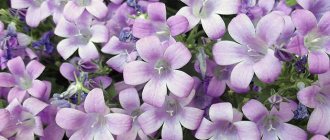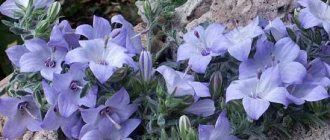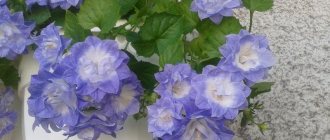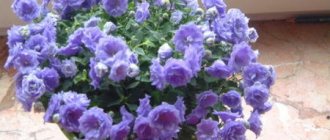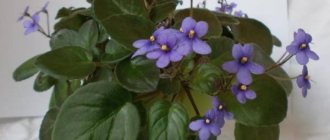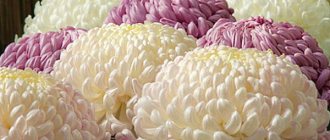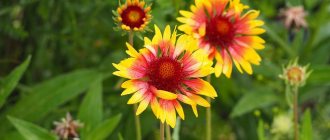Almost the entire summer period, an amazing plant with bright blue or white flowers from the bellflower family, the Carpathian bellflower, blooms in the open ground. The cultivation of numerous varieties of this plant is best achieved when planted on the southern slopes of alpine hills and in rockeries. How to take care of the plant? What are the most productive methods of propagating Carpathian bellflower? You will find answers to questions about the agricultural technology of bells in this article.
Carpathian bell: varieties and varieties
People called these cute flowers: chenilles, chebotki, bells. More than 300 species of Campanula are known. Recently, breeders have been developing new unique varieties of perennial bells suitable for planting on alpine hills.
These low perennial plants fit perfectly into landscape design
Double and non-double varieties of Carpathian bellflower, which are painted in white, pink shades and the entire spectrum of blue, have a special charm. The perennial Carpathian bell reaches only 30 cm in height; the plant's delicate stems grow anew every spring. The plant has two types of leaves: large ones are collected in a neat rosette, smaller leaves are arranged alternately on the stems. Campanula forms a lush bush, each shoot of which is crowned with single bell-shaped flowers. Flowering usually begins in mid-summer and lasts until autumn, the duration depends on the variety of bells.
Advice! Removing faded inflorescences will stimulate lateral branching and the formation of new buds. Drastic pruning of the Carpathian bellflower bush causes a second wave of plant flowering.
Varieties
The wild species is rarely grown in gardens; it is quite capricious. Varieties based on it are used for design; they are more adapted to garden conditions and grow without problems on cultivated lands. Below are several common varieties of Carpathian bellflower with descriptions and photos.
Gnome is a dwarf variety of the crop, no more than 15 cm in height. It is used as a ground cover plant in landscape design. Despite the short stems, the crop is capable of growing up to 50 cm in diameter. The variety is available in two petal color options – white and blue.
The Gnome variety has the longest flowering period - from early June to mid-October
Blue Clips
Blue Clips (or “blue clips”) are the most popular in ornamental gardening. It grows up to 30 cm in height, forms a dense bush, densely covered with large violet-blue flowers. Varieties with dark colors require sunny places for planting; in the shade the shade of the petals turns pale. Carpathian bell Blue Clips is often grown at home as an hanging plant. Planted in pots or portable containers. Decorate balconies or summer verandas.
Alba
Alba is a tall plant. The main foliage is at the base of the bush, along the stem the leaves are light green, narrow, up to 1.5 cm long. The flowers are large, white, five-petaled with green staminate filaments. The plant does not require lighting; it grows in partial shade and in open areas. It does not tolerate high air humidity and loses its decorative effect in unfavorable conditions.
Alba's flowering period is 70 days starting from mid-June
Celestine
Celestine is a perennial plant 25 cm high with erect, rigid stems, along the length of which there are many buds. The flowers are large – 5–6 cm in diameter. The leaves are long-petiolate, elongated, heart-shaped, with jagged edges, and bright green. The petals are blue with a purple tint and can fade in the sun.
The Celestina bell blooms from June to September.
Isabelle
Isabel (Isabel) is a compact medium-sized bush with thin stems, the length of which is 20–25 cm. The flower of the Carpathian bell Isabel is cup-shaped, large, single. Increased foliage is observed in the lower part of the plant. The leaf blades along the stems are short and narrow. Petals are heart-shaped, light blue.
Isabel is one of the long-flowering varieties of Carpathian bellflower
The first buds open in early June, the last ones before frost.
Planting a bluebell
When planting perennial Carpathian bellflower in open ground, it is worth considering some subtleties:
- The plant can grow well in one place for more than 5 years, provided the planting site is correctly selected.
- It is best to place bluebell bushes in a sunny place. The plant can tolerate light shading, but in this case the color of the flowers fades somewhat.
Try to protect the bell from waterlogging - The bell does not tolerate stagnant water, so it is worth providing for good drainage. The ideal place for the plant is a rocky hill. Excessive water at the roots in winter causes the roots to freeze and the plant to die.
- The soil in the place where the Carpathian bell is grown should ideally have a weak alkaline reaction. Plants develop normally in soils with a neutral reaction. Before planting plants, deep digging of the soil and the introduction of humus is required, as well as agrotechnical measures to reduce soil acidity.
A bright reward for hard work - exquisite bouquets
Practice shows that planting material is considered very capricious. But don’t lose heart, just be patient and act
First of all, it is important to know when to plant Carpathian bellflower seedlings in order to successfully propagate the flower. This is the way to enjoy its flowering this year.
To grow seedlings, planting material is sown in early March or late February.
It is advisable to sow seeds in open ground in mid-May in spring or early November in autumn.
First, high-quality permeable soil is prepared by mixing turf soil with humus and coarse river sand (6:3:1). The finished mixture is disinfected in a preheated oven for about 40 minutes. Some gardeners use a water bath for this purpose.
The next stage is the preparation of planting material. It is soaked in warm water for 5 hours to increase the germination of the plant.
Then they begin planting the plant, performing the following procedures:
- containers are filled with substrate;
- moisten the surface with a spray bottle;
- sowing seeds;
- Lightly press down the crops with your hand without covering them with a layer of soil;
- glass or plastic film is placed on top of the containers;
- The boxes are placed in a warm and bright room.
Before the first greenery appears, the surface of the earth is regularly moistened. If the crops are covered with glass, condensation is removed from its inner surface every day. It is enough to ventilate the film in the fresh air. The first shoots appear after about 25 days.
The temperature of the room where the crops are placed must be at least 20° C.
In order for the plant to adapt to the external environment, pinning is carried out. To do this, open the containers for 20 minutes every day. When the seedlings reach 5 cm, the cover is removed. Dense crops dive, leaving stronger options. All this time they are moistened with a sprayer. In May, when the soil warms up well, the sprouts are planted in a flowerbed or alpine hill.
As you can see, any effort is always rewarded. Various varieties of Carpathian bellflower are increasingly appearing in flower beds near country houses. Why not give yourself such a bright pleasure? It is enough to pick up the tools and act according to the established rule.
Plant care
It is not at all difficult to care for a bell in the open ground. The plant can do without watering in the spring months, when the roots receive enough moisture from melt water.
After wintering, the plants should be inspected and dead parts of the bushes should be removed.
To prevent the plant's roots from suffering from the heat, mulch the soil under the bell
During extreme heat, to retain moisture, it is necessary to mulch the soil in the beds with plants. Bluebells that grow on rocky hills do not require mulching in the summer.
Advice! Campanula does not tolerate the proximity of weeds: plant care includes timely weeding and removal of weeds from flower beds.
Rules for caring for and growing in the garden
Caring for a bell is easy. This is an unpretentious plant that even a child can handle growing.
Watering
If it rains regularly, then the bell does not need watering. The soil should be moistened only during dry periods. To do this, pour up to 10-20 liters of settled water onto each m2. The rest of the time, the bell roots will be able to get moisture on their own.
Top dressing
Perennial bells are fed 2 times a year. The first time this is done with the help of nitrogen fertilizers (urea, ammonium nitrate). Powder or granules are simply scattered on the ground (or even snow) in an amount of 15-20 g per m2. This needs to be done at the end of March. An alternative to mineral supplements is organic. After the snow melts, it is enough to water the flowerbed with mullein (1 kg of manure per 10 liters of water) or infusion of chicken manure (500 g of manure per bucket of water).
The second feeding is carried out during the mass formation of buds. During flowering, bells especially need potassium. There is a lot of it in mineral fertilizers intended for flowering plants (Agricola, Kemira). 15 g of fertilizers are diluted in a bucket of water and watered in a flower bed. Consumption – 5 l per m2. You can replace mineral fertilizers with ash (500 g per m2).
Loosening, mulching
You need to loosen the soil after each watering. This is not difficult, since the bells rarely need to be watered.
Pinching, pinching, pruning
Carpathian bells do not require mandatory pruning. But you can help the flowers form not a narrow, but a lush and compact bush, which will form several times more buds. To do this, you only need to pinch the top points of the central and lateral shoots of the 1st order. This will stimulate side branch growth but will delay flowering by about 2 weeks.
Transfer
In one place, bells can grow from 5 to 10 years. This depends on the condition of the soil and how well you have placed the flower bed. If you notice that the bells have begun to form weak bushes, and the flowers have become smaller, it’s time to replant them.
Plant propagation
The Carpathian bell can be propagated by dividing the bush and seeds, which ripen in boxes by the end of September. Growing a plant from seeds is quite a troublesome task, since the seedlings are very weak and tender. When self-sowing, campanula grow in the spring adapted to local conditions. It is recommended to sow seeds in autumn or spring. Flowering specimens grown from seeds will bloom in 2-3 years.
The most convenient way to propagate bluebells is by dividing the bush.
Dividing the bush is only suitable for mature, fully grown plants that are over 3 years old.
In addition to these methods of propagation, the bell is easily propagated in the summer by green cuttings. Cuttings are cut into segments with several internodes from healthy bushes. Rooting is carried out in a greenhouse or greenhouse. Excellent results were observed when using growth stimulants during the rooting period of green cuttings. Preparations "Epin" or "Kornevin" will significantly reduce the risk of plant death and also guarantee the rapid formation of a strong root system. Grown-up specimens are transplanted to a permanent place in early autumn or spring.
Growing seedlings
Usually the Carpathian bell is grown by seedlings. Next, we will consider all the nuances of this process.
Stratification
To harden the planting material, they begin to prepare it in February. From this month until March, you should keep the seeds at a temperature of +20 degrees, not forgetting to moisten them regularly. The procedure will make the seed material more stable and viable.
If during the stratification process some of the seeds sprouted, they should be transplanted into the ground. After a month of hardening at a temperature of +20 degrees, the next month and a half, the seeds must be kept at a temperature of +4 to -4 degrees.
Sowing
After hardening, the bell seeds are placed in containers with soil; there is no need to bury the seeds. Germination occurs at a temperature of +10-15 degrees.
The seeds do not require standard watering; instead, they must be periodically sprayed with a spray bottle. This gentle moisturizing will prevent the seeds from washing away.
Seedling care
Carpathian bellflower seeds germinate 10-25 days after sowing in the ground. Since the seeds are small, the seedlings usually turn out quite dense: they need thinning.
Picking is done as soon as the first pair of true leaves appear on the sprouts. In addition, it is necessary to regularly moisten the soil in the containers, as well as ventilate the seedlings. Two weeks after picking, fertilizing is applied for the first time.
At one month of age, Carpathian bellflower seedlings are ready to move into the open sky. By this time, the root system of the plant is already quite developed, and the seedlings themselves have managed to get stronger.
Attention: if you live in the southern region, you can plant the seeds directly in the garden bed, without first germinating the seedlings.
Diseases and pests
The Carpathian bellflower is practically not threatened by pests. Thin leaves and shoots of the plant suffer only from slug invasion. The preparations “Grom” and “Meta” will help to expel pests from plants.
Slugs can cause significant damage to bluebell leaves.
The leaves of bells may become rusty; preparations containing copper will help fight the disease. To prevent the spread of rust, it is useful to carry out preventive soil treatment in spring and autumn with Gumi or Fitosporin preparations.
Carpathian bellflower: combination with other plants
On an alpine hill, perennial bells are ideally combined in plantings with rock alyssum, aubrietta, lobelia, daisies and other perennial or annual plants for rocky gardens.
Bluebell looks great in a flowerbed with other perennials
The combination of blue and white bells planted side by side is very picturesque. Photos of landscape compositions using campanula confirm the ideal combination of blue bells with flowers in white, pink and yellow shades.
The plant fits perfectly with the emerald carpet of city lawns.
Origin and appearance ↑
This species is from the genus Campanula or Campanula. The Carpathian Mountains, as well as the mountains of Central Europe, are considered its homeland. In those places they can be found on limestone rocks. Sometimes they are content with a small gap between the stones.
This plant is perennial and herbaceous, forming a bush in the form of a hemisphere with a height of 15 to 30 centimeters. Large bell-shaped flowers are arranged one at a time. They can be colored in shades from white to dark purple. The seeds ripen from July to August. They are located in an oval-shaped fruit-box.
Carpathian bellflower in landscape design
In landscape design, the Carpathian bell is used for growing in rock gardens, alpine hills and rocky gardens.
Carpathian bellflower in the rock garden
In recent years, flowerpots with flowering plants have become popular in landscape design. The bell is ideal for these purposes.
Delicate flowers are planted in beds to frame paths and in mixed flower beds with low-growing plants.
